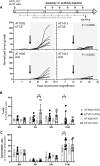Melanoma cells can be eliminated by sialylated CD43 × CD3 bispecific T cell engager formats in vitro and in vivo
- PMID: 33225419
- PMCID: PMC10992524
- DOI: 10.1007/s00262-020-02780-9
Melanoma cells can be eliminated by sialylated CD43 × CD3 bispecific T cell engager formats in vitro and in vivo
Abstract
Targeted cancer therapy with monoclonal antibodies has proven successful for different cancer types but is limited by the availability of suitable antibody targets. CD43s, a unique sialylated form of CD43 expressed by hematologic malignancies, is a recently identified target and antibodies interacting with CD43s may have therapeutic potential against acute myeloid leukemia (AML) and myelodysplastic syndrome. CD43s is recognized by the human antibody AT1413, that was derived from a high-risk AML patient who successfully cleared leukemia after allogeneic stem cell transplantation. Here we observed that AT1413 binds also to certain non-hematopoietic tumor cells, particularly melanoma and breast cancer. AT1413 immune precipitated CD43s from melanoma cells confirming that it recognizes the same target on melanoma as on AML. AT1413 induced antibody-dependent cellular cytotoxicity against short-term cultured patient-derived melanoma samples. However, AT1413 was unable to affect the growth of melanoma cells in vivo. To increase the efficacy of AT1413 as a therapeutic antibody, we generated two different formats of bispecific T-cell engaging antibodies (TCEs): one binding bivalently (bTCE) and the other monovalently (knob-in-hole; KiH) to both CD43s and CD3ε. In vitro, these TCEs redirected T-cell cytotoxicity against melanoma cells with differences in potencies. To investigate their effects in vivo, we grafted mice that harbor a human immune system with the melanoma cell line A375. Treatment with both AT1413 bTCE and AT1413 KiH significantly reduced tumor outgrowth in these mice. These data indicate a broad therapeutic potential of AT1413 that includes AML and CD43s-expressing solid tumors that originate from CD43-negative tissues.
Keywords: Antibody immunotherapy; Bispecific T-cell engaging antibodies; Breast cancer; Hematological cancers/leukemias; Post-translationally modified drug target; Skin cancers/melanoma.
Conflict of interest statement
MK, SEL, MGC, SEHV, CF, DB, EY, YBC, AQB, RS, JV, HS and PMH, have ownership interests in AIMM Therapeutics. MK, MAG, PMH, MDH and HS are inventors on patent WO2016209079A1.
Figures






Similar articles
-
A Chemo-enzymatically Linked Bispecific Antibody Retargets T Cells to a Sialylated Epitope on CD43 in Acute Myeloid Leukemia.Cancer Res. 2019 Jul 1;79(13):3372-3382. doi: 10.1158/0008-5472.CAN-18-0189. Epub 2019 May 7. Cancer Res. 2019. PMID: 31064847
-
Therapeutic afucosylated monoclonal antibody and bispecific T-cell engagers for T-cell acute lymphoblastic leukemia.J Immunother Cancer. 2021 Feb;9(2):e002026. doi: 10.1136/jitc-2020-002026. J Immunother Cancer. 2021. PMID: 33597219 Free PMC article.
-
Patient-derived antibody recognizes a unique CD43 epitope expressed on all AML and has antileukemia activity in mice.Blood Adv. 2017 Aug 18;1(19):1551-1564. doi: 10.1182/bloodadvances.2017008342. eCollection 2017 Aug 22. Blood Adv. 2017. PMID: 29296797 Free PMC article.
-
Looking ahead to CD3, T-cell engager bispecific antibodies for hematological malignancies.Expert Opin Biol Ther. 2024 Aug;24(8):761-772. doi: 10.1080/14712598.2024.2384086. Epub 2024 Jul 29. Expert Opin Biol Ther. 2024. PMID: 39069893 Review.
-
Progresses of T-cell-engaging bispecific antibodies in treatment of solid tumors.Int Immunopharmacol. 2024 Sep 10;138:112609. doi: 10.1016/j.intimp.2024.112609. Epub 2024 Jul 6. Int Immunopharmacol. 2024. PMID: 38971103 Review.
Cited by
-
Bispecific Antibodies Progression in Malignant Melanoma.Front Pharmacol. 2022 Mar 23;13:837889. doi: 10.3389/fphar.2022.837889. eCollection 2022. Front Pharmacol. 2022. PMID: 35401191 Free PMC article. Review.
-
The Current State of Treatment and Future Directions in Cutaneous Malignant Melanoma.Biomedicines. 2022 Mar 31;10(4):822. doi: 10.3390/biomedicines10040822. Biomedicines. 2022. PMID: 35453572 Free PMC article. Review.
-
T Cell Bispecific Antibodies: An Antibody-Based Delivery System for Inducing Antitumor Immunity.Pharmaceuticals (Basel). 2021 Nov 17;14(11):1172. doi: 10.3390/ph14111172. Pharmaceuticals (Basel). 2021. PMID: 34832954 Free PMC article. Review.
-
Recent Advancements in Cell-Based Therapies in Melanoma.Int J Mol Sci. 2024 Sep 12;25(18):9848. doi: 10.3390/ijms25189848. Int J Mol Sci. 2024. PMID: 39337333 Free PMC article. Review.
-
The Role of Glycosylation in Melanoma Progression.Cells. 2021 Aug 19;10(8):2136. doi: 10.3390/cells10082136. Cells. 2021. PMID: 34440905 Free PMC article. Review.
References
-
- Schmid P, Adams S, Rugo HS, Schneeweiss A, Barrios CH, Iwata H, Dieras V, Hegg R, Im SA, Shaw Wright G, Henschel V, Molinero L, Chui SY, Funke R, Husain A, Winer EP, Loi S, Emens LA. Atezolizumab and nab-paclitaxel in advanced triple-negative breast cancer. N Engl J Med. 2018;379:2108–2121. doi: 10.1056/NEJMoa1809615. - DOI - PubMed
MeSH terms
Substances
Grants and funding
LinkOut - more resources
Full Text Sources
Medical

